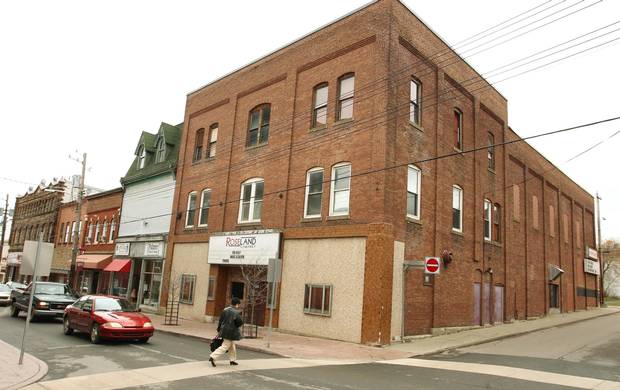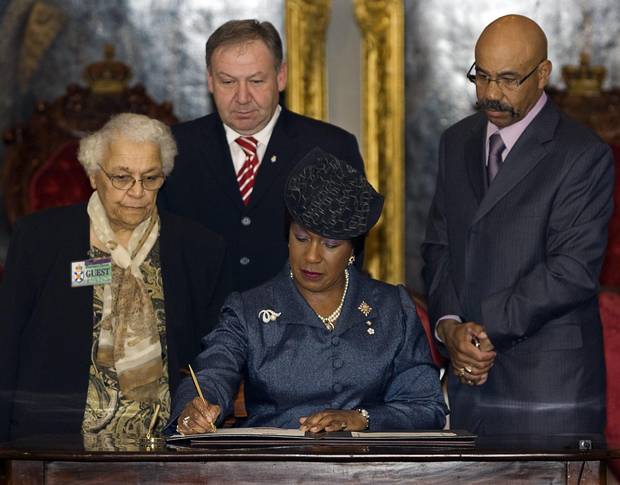Decades before we'd debate the absence of black Oscar nominees, Viola Desmond had a much more painful experience of racism at the movies.
In 1946, the black Nova Scotia woman was ejected from a New Glasgow cinema and jailed for refusing to leave a whites-only seating section. The incident has earned comparisons to Rosa Parks's confrontation on a bus in Alabama nine years later.
For Black History Month, Historica Canada is telling Ms. Desmond's story in a new Heritage Minute released today, the first ever to have a famous woman of colour as its central focus. Here's a closer look at Ms. Desmond's story, and how the Heritage Minutes have portrayed race and gender over the years.
WHO IS VIOLA DESMOND?
In 1946, Ms. Desmond, who ran a beauty-products business, had car trouble and had to stop in New Glasgow while her car was being repaired. She decided to take in a movie at the Roseland Theatre to pass the time, but sat on the main floor, an area the cinema reserved for white patrons.

A nightclub, once home to the Roseland Theatre, is shown in downtown New Glasgow, N.S., in 2010.
PAUL DARROW FOR THE GLOBE AND MAIL
Ms. Desmond, portrayed in the new Heritage Minute by actress Kandyse McClure, refused the staff's demands that she sit in the balcony instead. When the police came, they dragged her out and held her in jail overnight. She was later convicted of tax evasion, because the tax on the floor seats was one cent higher than for the balcony seats. She appealed the case, without success.
In 2010, the Nova Scotia government gave Ms. Desmond a posthumous pardon. It was signed into law by Mayann Francis, the province's black lieutenant-governor of the time.

Nova Scotia lieutenant-governor Mayann Francis signs the official pardon for Viola Desmond on April 15, 2010, as Ms. Desmond’s sister Wanda Robson, left, premier Darrell Dexter and Percy Paris, minister of African Nova Scotian Affairs, look on at the provincial legislature.
ANDREW VAUGHAN/THE CANADIAN PRESS
HERITAGE MINUTES AT A GLANCE
Since 1991, Historica Canada's Heritage Minutes have dramatized key moments in Canada's history from Jacques Cartier's arrival in New France to the invention of basketball. (If the phrase "I smell burnt toast!" rings a bell, chances are you've seen the one about Wilder Penfield's neurological research.)
The Globe analyzed the race and gender of the primary subjects in the 81 previous Minutes, which are available to view on Historica Canada's YouTube channel.
Of the previous Minutes, 49 can be classified as profiles of single individuals, as opposed to episodes about events or groups of people. Of the individuals profiled, 31 are white men.
There are 11 Minutes profiling famous women (12 if we include the episode Responsible Government, which centres on Queen Victoria). The women include feminist pioneers like Emily Murphy and Nellie McClung; War of 1812 heroine Laura Secord; and Québécois chanteuse Mary (La Bolduc) Travers. All the women profiled are white.
Three Minutes profile black men. One shows Jackie Robinson in his debut with the Montreal Royals, before he broke U.S. Major League Baseball's colour barrier:
… another showcases Maurice Ruddick, a survivor of the 1958 mine disaster in Springhill, N.S.:
… and a recent episode from 2012 features Richard Pierpoint, a Senegalese former slave who won his freedom fighting for the British in the American Revolution.
The only Heritage Minute with a black female protagonist, albeit a fictitious one, is Underground Railroad, which features "Liza," the daughter in a family of escaped American slaves.
Underground Railroad is one of several Minutes of the 1990s that highlight women and minorities with composite characters standing in for larger groups, such as the unnamed Chinese railroad worker in Nitro:
… the 19th-century female schoolteacher in Rural Teacher:
… or the indigenous family in Syrup that teaches French-Canadian settlers how to enjoy maple syrup.
But while Viola Desmond breaks the mould in some respects, in another way it's very traditional: It's the 11th Minute set in the 1940s, the most depicted decade of any in the Heritage Minutes.
HERITAGE MINUTES: WHICH DO YOU LIKE MOST?
Some Heritage Minutes are well-known for clunky lines delivered with breathless sincerity, making them into quotable favourites. How does the Viola Desmond episode stack up against them? We've constructed a totally arbitrary ballot to see what you think:
With a report from Oliver Moore
